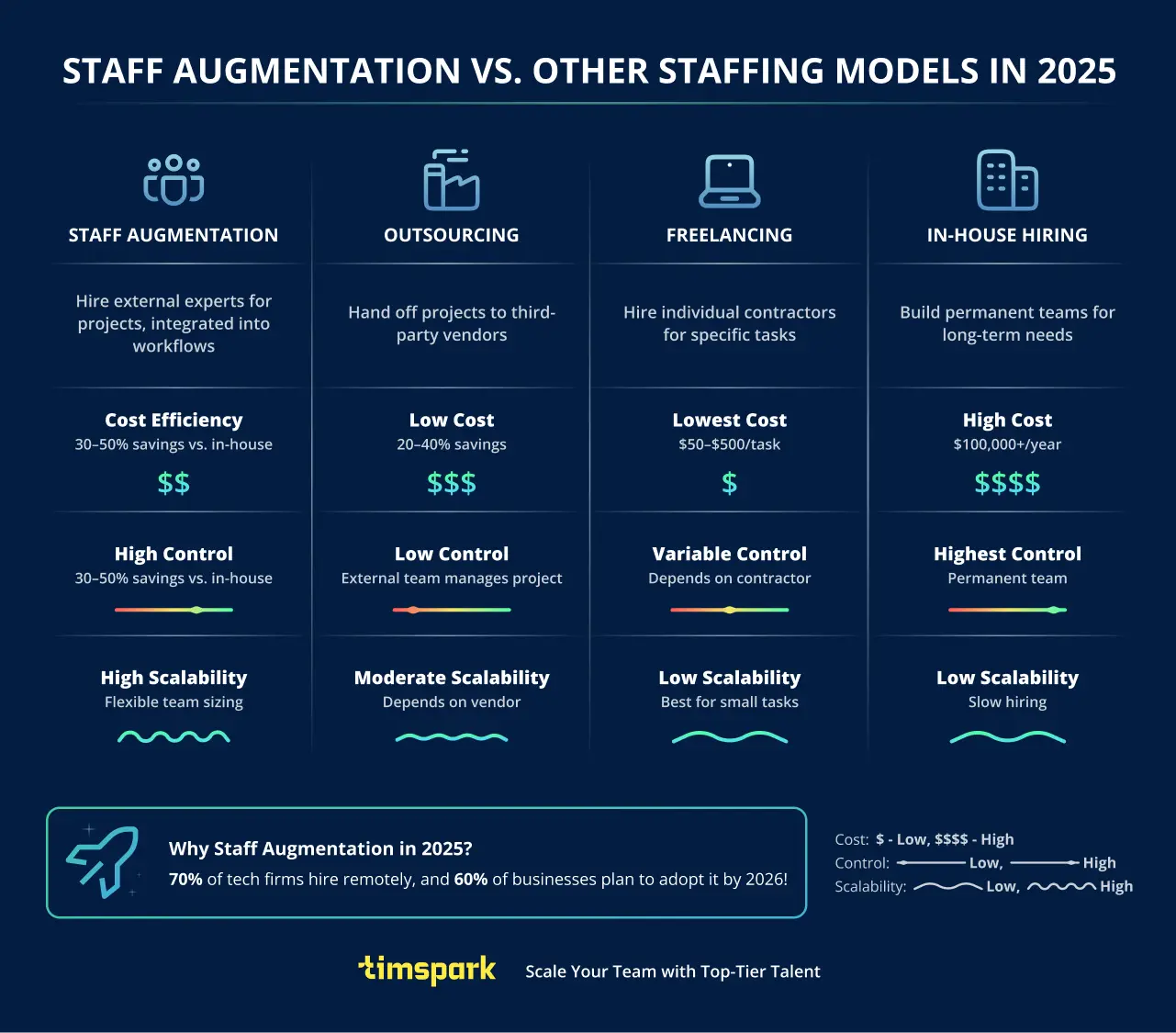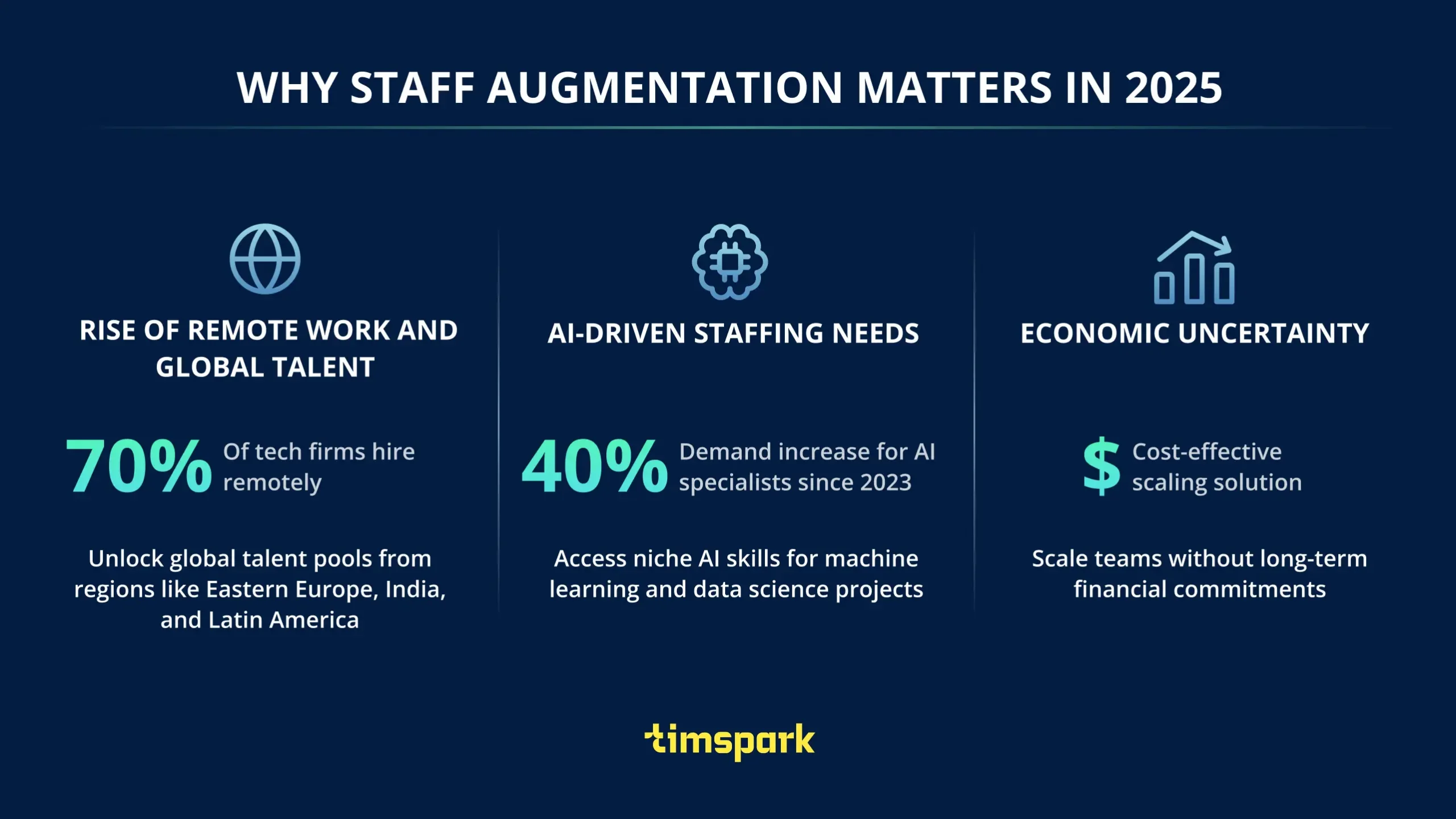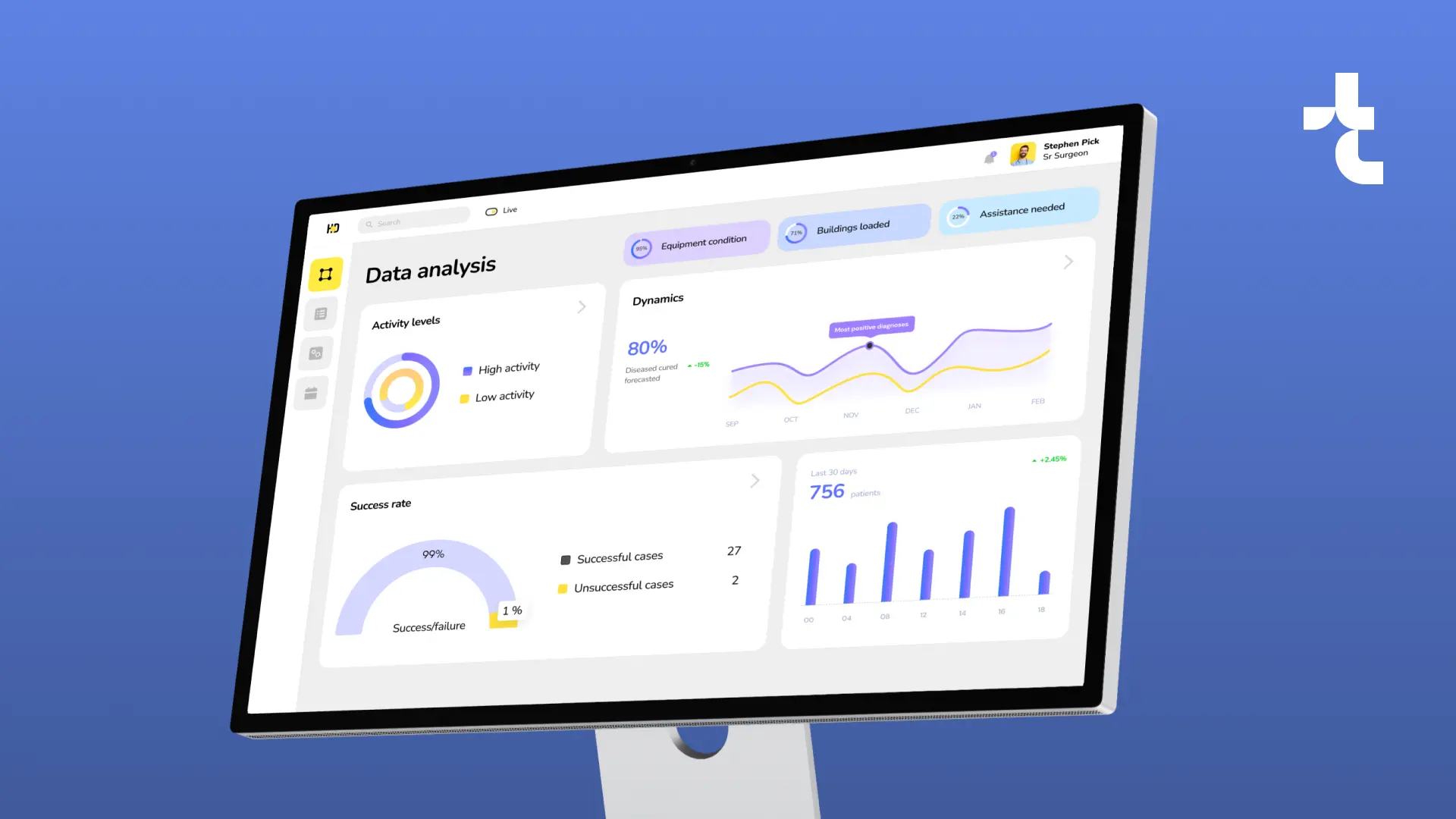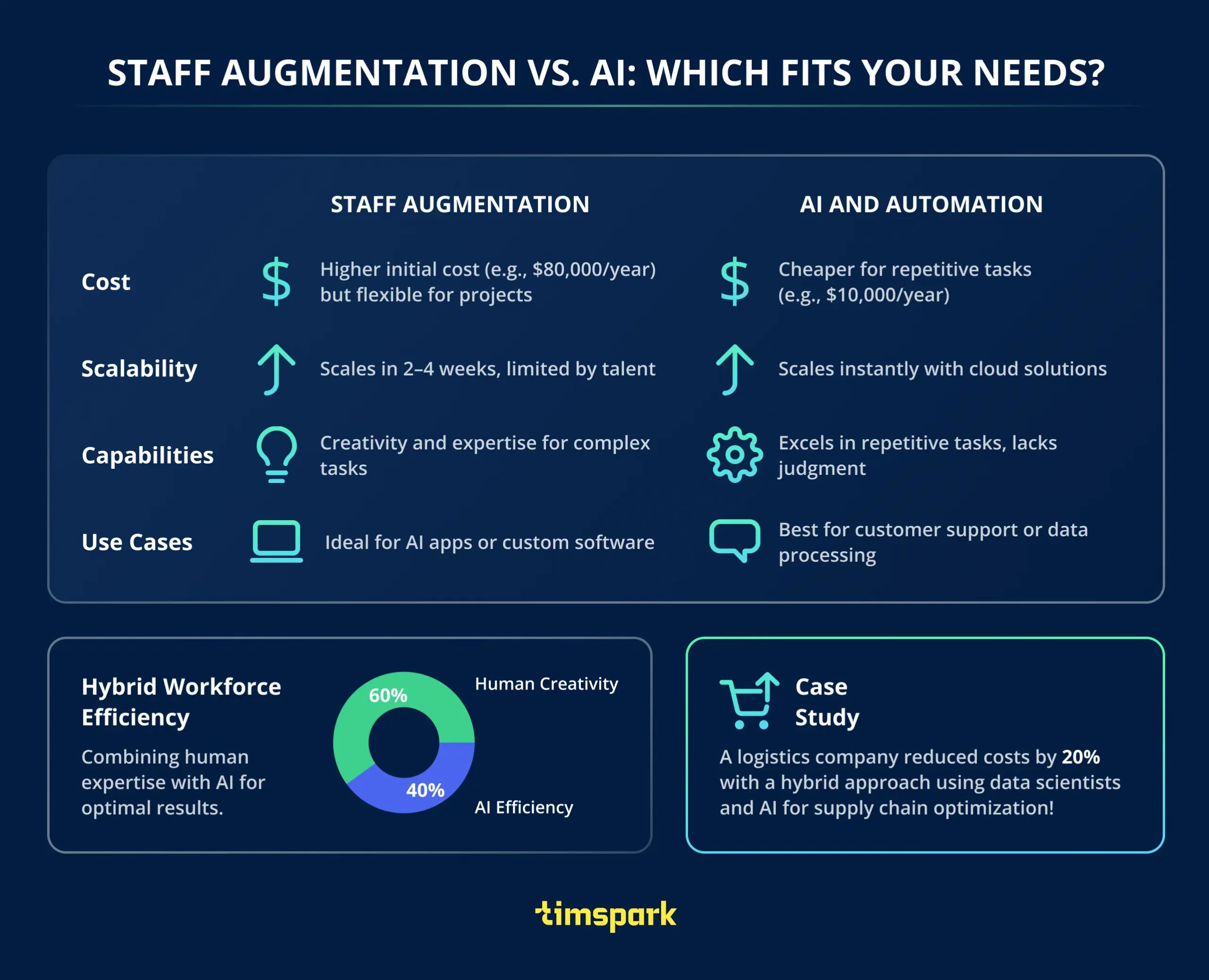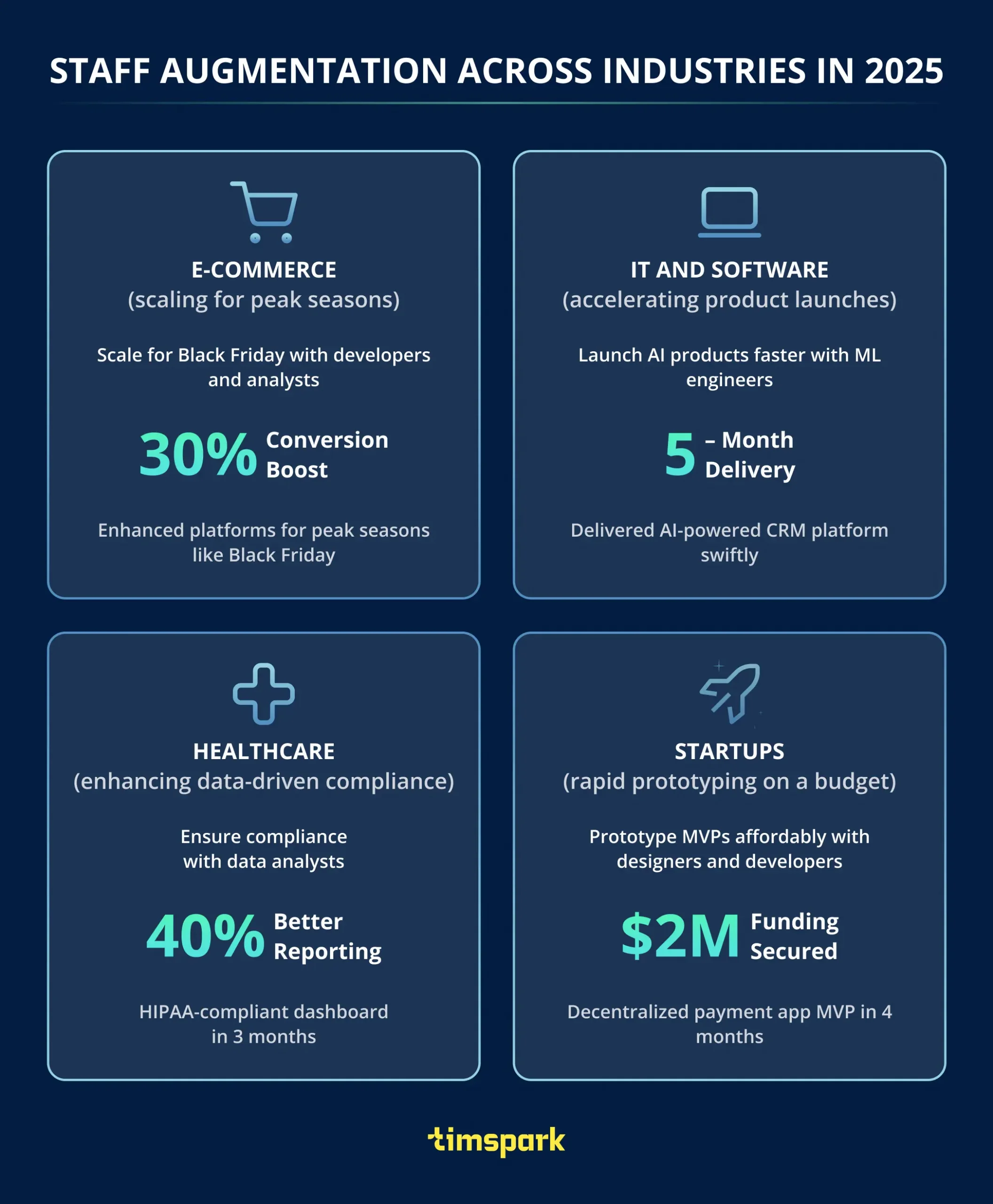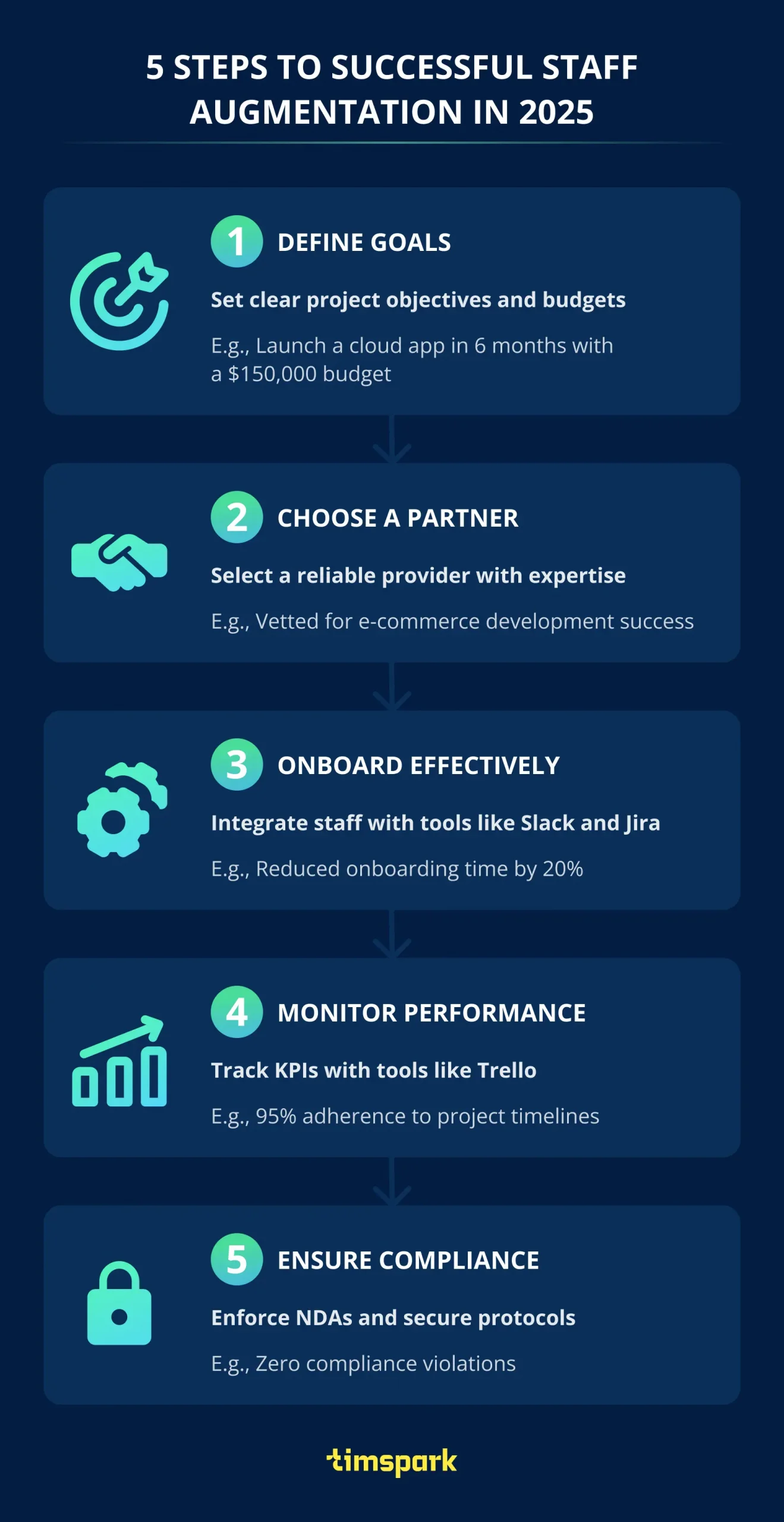The Ultimate Guide to Staff Augmentation in 2025: Pros, Cons, and Strategies for Success
Alina Ramanenkava, Growth Marketing Manager
Last updated: May 23, 2025
Introduction
The current rapid business environment demands access to suitable talent quickly to maintain agility and competitiveness. Staff augmentation functions as a transformative solution that allows companies to expand their teams effectively while avoiding the costs associated with conventional recruitment. The staffing model of staff augmentation will transform how organizations handle projects including AI-driven app development and e-commerce holiday rushes because 60% of businesses planning to adopt staff augmentation by 2026.
The guide examines staff augmentation in 2025 by evaluating its benefits and challenges alongside its strategic applications. The guide provides HR managers, IT leaders and startup founders with insights on using global talent to their advantage while integrating AI and selecting appropriate staffing solutions. Ready to future-proof your workforce? We will examine how staff augmentation enables your success through insights from experts such as Timspark who specialize in scalable staffing solutions.
What is Staff Augmentation?
Key Features of Staff Augmentation
- Temporary or Project-Based: Hire experts for short-term needs, such as a three-month AI prototype or a holiday season e-commerce surge.
- Global Talent Access: Tap into diverse skill sets worldwide, from Eastern European developers to Indian data scientists.
- Seamless Integration: Augmented staff use your tools (e.g., Slack, Jira) and follow your processes, ensuring alignment with company goals.
- Cost Efficiency: Avoid long-term commitments and reduce recruitment costs by up to 30–50% compared to in-house hiring.
Staff Augmentation vs. Other Models
- Outsourcing: Transfers full project responsibility to an external team, often with less control over day-to-day operations. Learn more about outsourcing vs. staff augmentation in Timspark’s guide to staffing models.
- Freelancing: Involves hiring individual contractors for small tasks, often via platforms like Upwork, but lacks the structure for complex projects.
- In-House Hiring: Builds permanent teams but requires significant time (2–3 months on average) and investment for recruitment and onboarding.
Why It’s Relevant in 2025
Staff augmentation has become a popular choice because of remote work expansion along with AI advancements and economic instability. Tech firms employ remote workers in 70% of hiring cases while businesses demand specialized knowledge in machine learning and blockchain fields. Staff augmentation fills these gaps while delivering both flexibility and rapid solutions. Businesses partner with Timspark to link their operations with leading experts who deliver flawless project results.
Why Staff Augmentation Matters in 2025
Staff augmentation emerged as a fundamental business strategy in 2025 because organizations needed to adapt to the fast-changing global environment. Technological advancements combined with economic changes and the demand for agility are driving a rapid increase in the need for workforce solutions that are flexible and scalable while also specializing in specific areas. Staff augmentation remains essential for businesses that want to maintain their competitive edge during this year.
Key Trends Driving Staff Augmentation
- Rise of Remote Work and Global Talent: The normalization of remote work has unlocked access to global talent pools. According to industry reports, 70% of tech firms now hire remotely, enabling companies to tap into skilled professionals from regions like Eastern Europe, India, and Latin America without geographical constraints.
- AI-Driven Staffing Needs: The explosion of AI technologies has created a 40% increase in demand for AI specialists since 2023, per labor market data. Businesses require experts in machine learning, natural language processing, and data science to integrate AI into their operations, and staff augmentation provides rapid access to these niche skills.
- Economic Uncertainty: With fluctuating markets, companies are prioritizing cost-effective solutions. Staff augmentation allows businesses to scale teams without the long-term financial commitments of full-time hires, offering a buffer against economic volatility.
Business Impact
Staff augmentation empowers businesses with:
- Scalability: Quickly adjust team sizes to match project demands, such as ramping up for a product launch or scaling down post-project.
- Agility: Respond to market changes or technological disruptions by onboarding specialized talent in weeks, not months.
- Access to Niche Skills: Hire experts in cutting-edge fields like AI, blockchain, or cybersecurity, ensuring projects stay ahead of the curve.
Case Studies with Staff Augmentation
Pros of Staff Augmentation
Businesses that aim to optimize their workforce in 2025 will discover numerous compelling advantages through staff augmentation. This staffing approach enables organizations to efficiently fulfill project requirements by supplying specialized talent with both flexibility and cost-effectiveness. The following section outlines main advantages while providing real-world examples and relevant data to support them.
Cost Efficiency
Staff augmentation significantly reduces overhead compared to traditional full-time hiring. Recruitment costs, benefits, and onboarding expenses for permanent employees can be substantial, whereas augmented staff are hired for specific projects or durations. Industry estimates suggest businesses can save 30–50% on recruitment and operational costs by opting for staff augmentation instead of in-house hires.
Example: A mid-sized e-commerce company avoided $100,000 in annual overhead by augmenting its team with temporary UX designers for a website redesign, rather than hiring full-time staff.
Flexibility
The ability to scale teams up or down based on project needs is a hallmark of staff augmentation. Businesses can quickly expand their workforce for short-term initiatives or reduce headcount once projects conclude, without the complexities of layoffs or long-term contracts.
Example: A software firm scaled its development team by 10 augmented engineers during a three-month product sprint, then seamlessly downsized post-launch, maintaining budget control.
Specialized Skills
Staff augmentation grants access to experts in high-demand fields like AI, cloud computing, and cybersecurity. This is particularly valuable for projects requiring niche expertise that in-house teams may lack, enabling companies to stay competitive in fast-evolving industries.
Example: A healthcare provider augmented its team with two data scientists to develop a predictive analytics tool for patient outcomes, leveraging skills unavailable internally.
Speed
Onboarding augmented staff is significantly faster than recruiting full-time employees. While in-house hiring can take 2–3 months, staff augmentation providers can deliver qualified talent in 2–4 weeks, accelerating project timelines.
Example: A tech startup onboarded a team of augmented blockchain developers within three weeks to meet a critical deadline for a decentralized finance (DeFi) platform launch.
Global Talent
Staff augmentation opens the door to diverse, global talent pools. Companies can hire professionals from regions known for specific expertise, such as Eastern Europe for software development or India for data analytics, often at competitive rates.
Example: A U.S.-based marketing agency augmented its team with graphic designers from Latin America, benefiting from cost savings and culturally diverse creative input.
Summarizing the Pros of Staff Augmentation
Benefit | Description | Real-World Example |
Cost Efficiency | Saves 30–50% on recruitment and overhead vs. full-time hires. | E-commerce company saved $100,000 on UX redesign. |
Flexibility | Scale teams up/down based on project needs without long-term commitments. | Software firm adjusted team size post-sprint. |
Specialized Skills | Access experts in AI, cloud, or cybersecurity for niche projects. | Healthcare provider built predictive analytics tool with data scientists. |
Speed | Onboard talent in 2–4 weeks vs. 2–3 months for in-house hiring. | Startup launched DeFi platform with blockchain developers in three weeks. |
Global Talent | Hire from diverse markets like Eastern Europe or India for expertise and value. | Marketing agency gained creative input from Latin American designers. |
Ready to scale your team with top-tier IT talent?
Cons of Staff Augmentation
Businesses experience major benefits from staff augmentation but need to manage specific difficulties to achieve successful implementation. Effective implementation requires businesses to both understand these drawbacks and apply strategies that reduce their impact. This section covers the main disadvantages while offering practical solutions and demonstrating their application in real-world scenarios.
Integration Challenges
Augmented staff, often working remotely or from different cultural backgrounds, may face difficulties integrating with in-house teams. Communication gaps, time zone differences, or misaligned work practices can hinder collaboration and project cohesion.
Mitigation Tip: Use collaboration tools like Slack or Microsoft Teams to streamline communication. Conduct virtual team-building activities and establish clear workflows to bridge cultural and operational gaps.
Example: A tech company faced delays due to time zone mismatches with augmented developers in Asia. By adopting asynchronous communication via Jira and scheduling overlap hours, they reduced delays by 25%.
Management Overhead
Overseeing augmented staff requires active management to align them with project goals and company standards. Without clear oversight, external talent may struggle to meet expectations, increasing the workload for internal managers.
Mitigation Tip: Assign a dedicated project manager to oversee augmented staff. Set clear KPIs and use tools like Trello or Asana to track progress and ensure alignment.
Example: A retail firm experienced scope creep in a website revamp project due to unclear directives for augmented designers. Implementing weekly check-ins and a shared Asana board improved task clarity and delivery.
Security Risks
Sharing sensitive company data with external staff raises concerns about data privacy and intellectual property protection. Without proper safeguards, businesses risk breaches or misuse of confidential information.
Mitigation Tip: Enforce robust non-disclosure agreements (NDAs) and use secure platforms like encrypted cloud storage for data sharing. Conduct security training for augmented staff to ensure compliance with protocols.
Example: A financial services company mitigated risks by using end-to-end encrypted file-sharing tools and requiring augmented analysts to complete cybersecurity training, preventing any data leaks.
Limited Loyalty
Temporary staff may lack the long-term commitment and loyalty of full-time employees, potentially affecting team morale or project investment. Augmented workers may prioritize their next contract over deep engagement with the current project.
Mitigation Tip: Foster a sense of inclusion by involving augmented staff in team meetings and recognizing their contributions. Offer performance-based incentives to encourage dedication.
Example: A startup noticed disengagement from augmented coders nearing the end of a project. By offering bonuses tied to project milestones and including them in team celebrations, they boosted engagement by 30%.
Common Challenges and Solutions
Challenge | Description | Mitigation Strategy |
Integration Challenges | Cultural or communication gaps with external teams. | Use Slack/Teams, virtual team-building, and clear workflows. |
Management Overhead | Requires oversight to align augmented staff with goals. | Assign a project manager, set KPIs, and use Trello/Asana. |
Security Risks | Data privacy concerns when sharing sensitive information. | Enforce NDAs, use encrypted platforms, and provide security training. |
Limited Loyalty | Temporary staff may lack long-term commitment. | Include in team activities, recognize contributions, and offer incentives. |
Staff Augmentation vs. AI and Automation
As businesses in 2025 strive for efficiency and innovation, the choice between staff augmentation and AI-driven automation is pivotal. While staff augmentation leverages human talent to address complex, creative, or specialized tasks, AI and automation excel in repetitive, data-driven processes. Understanding their strengths, limitations, and potential for synergy is key to optimizing workforce strategies.
AI’s Role in Staffing
AI technologies, such as chatbots, automated coding tools, and predictive analytics, are transforming how businesses handle operational tasks. AI agents can perform functions like customer service, basic software development, or data analysis with minimal human intervention, offering a compelling alternative to human staffing for specific use cases.
Examples: AI-powered chatbots handle 80% of customer inquiries for e-commerce platforms, while tools like GitHub Copilot assist with code generation, reducing developer workloads.
Comparison: Staff Augmentation vs. AI
Factor | Staff Augmentation | AI and Automation |
Cost | Higher initial cost (e.g., $80,000/year for a skilled developer) but flexible for project-based needs. | Often cheaper for repetitive tasks (e.g., $10,000/year for an AI chatbot subscription). |
Scalability | Scales with hiring, typically in 2–4 weeks, but limited by talent availability. | Scales instantly with cloud-based solutions, no hiring delays. |
Capabilities | Offers creativity, adaptability, and expertise for complex, non-standardized tasks. | Excels in repetitive, rule-based tasks but lacks human judgment. |
Use Cases | Ideal for strategic projects like AI app development or custom software. | Best for high-volume tasks like customer support or data processing. |
Insight: AI is cost-effective for standardized processes, but staff augmentation shines in projects requiring human ingenuity, such as designing innovative user interfaces or solving unique business challenges.
Hybrid Approach
Combining staff augmentation with AI and automation yields optimal results, leveraging the strengths of both. Augmented human teams can focus on high-value, creative tasks while AI handles routine operations, creating a balanced and efficient workforce.
Example: A logistics company augmented its team with data scientists to design a custom supply chain optimization platform, while deploying AI algorithms to automate inventory tracking, reducing costs by 20% and improving delivery times.
Combining staff augmentation with AI and automation yields optimal results, leveraging the strengths of both. Augmented human teams can focus on high-value, creative tasks while AI handles routine operations, creating a balanced and efficient workforce.
Example: A logistics company augmented its team with data scientists to design a custom supply chain optimization platform, while deploying AI algorithms to automate inventory tracking, reducing costs by 20% and improving delivery times.
Industry Use Cases
Staff augmentation is a versatile staffing solution that empowers diverse industries to address unique challenges and seize opportunities in 2025. By providing access to specialized talent on demand, it enables businesses to scale efficiently, innovate rapidly, and meet project goals. Below are key industry use cases demonstrating how staff augmentation drives success.
E-commerce: Scaling for Peak Seasons
E-commerce businesses face fluctuating demand, especially during peak seasons like Black Friday or holiday sales. Staff augmentation allows these companies to quickly onboard developers, UX designers, or data analysts to enhance platforms, optimize user experiences, or analyze customer behavior, then scale down post-season.
Example: An online retailer augmented its team with five front-end developers and two data analysts to revamp its website and implement real-time analytics for Black Friday 2024. The result was a 30% increase in conversions and a seamless customer experience during peak traffic.
IT and Software: Accelerating Product Launches
The IT and software sector relies on cutting-edge expertise to deliver innovative products. Staff augmentation provides access to specialists in AI, blockchain, or cloud computing, enabling companies to meet tight deadlines and stay ahead of competitors.
Example: A SaaS company developing an AI-powered CRM platform augmented its team with three machine learning engineers and a DevOps specialist. The augmented team delivered the product in five months, securing a first-mover advantage in a competitive market.
Healthcare: Enhancing Data-Driven Compliance
Healthcare organizations increasingly require data analysts, cybersecurity experts, and compliance specialists to manage regulatory requirements and leverage data for better patient outcomes. Staff augmentation offers a cost-effective way to access these skills for specific projects.
Example: A hospital network augmented its team with two data analysts to develop a HIPAA-compliant data dashboard for tracking patient care metrics. The project was completed in three months, improving compliance reporting by 40%.
Startups: Rapid Prototyping on a Budget
Startups often operate with limited resources and tight timelines, making staff augmentation ideal for rapid prototyping and product development. By hiring specialized talent temporarily, startups can test ideas and launch minimum viable products (MVPs) without long-term commitments.
Example: A fintech startup augmented its team with two blockchain developers and a UI/UX designer to prototype a decentralized payment app. The MVP was launched in four months, attracting $2 million in seed funding.
How to Implement Staff Augmentation Successfully
Strategic planning and execution are essential for the effective implementation of sstaff augmentation to integrate new staff smoothly while aligning with business goals for maximum investment returns. Organizations will have access to tested procedures and technologies to ensure successful staff augmentation by 2025. This guide presents sequential steps for reaching your best possible results.
Step 1: Define Goals
Clearly outline the objectives of the staff augmentation initiative, such as meeting a project deadline, accessing niche skills, or managing budget constraints. Align staffing needs with specific project deliverables, timelines, and success metrics.
Example: A tech company defined its goal as launching a cloud-based app within six months, requiring three augmented cloud engineers to complement its in-house team, with a budget cap of $150,000.
Step 2: Choose a Partner
Select a staff augmentation provider based on expertise, scalability, and reliability. Evaluate potential partners by reviewing their track record, client testimonials, and ability to source talent in your required domain (e.g., AI, cybersecurity). Ensure they offer flexible contracts and robust support.
Example: A retailer vetted providers and chose one with a strong portfolio in e-commerce development, securing four augmented developers who delivered a Black Friday-ready platform on time.
Step 3: Onboard Effectively
Facilitate smooth integration of augmented staff by providing access to collaboration tools like Slack, Jira, or Microsoft Teams. Share detailed project documentation, conduct orientation sessions, and introduce augmented staff to in-house teams to foster collaboration.
Example: A healthcare firm onboarded augmented data analysts by setting up Jira workflows and hosting a virtual kickoff meeting, reducing onboarding time by 20% and ensuring alignment.
Step 4: Monitor Performance
Track the performance of augmented staff using key performance indicators (KPIs) such as project milestones, code quality, or task completion rates. Use project management tools like Trello or Asana to monitor progress and provide regular feedback to maintain accountability.
Example: A SaaS startup monitored its augmented developers’ progress via GitHub commits and biweekly sprint reviews, achieving 95% adherence to project timelines.
Step 5: Ensure Compliance
Address data privacy, intellectual property, and legal requirements by implementing robust non-disclosure agreements (NDAs), secure data-sharing protocols, and compliance training. Verify that the augmentation provider adheres to industry standards like GDPR or HIPAA, if applicable.
Example: A financial services company enforced NDAs and used encrypted cloud storage for its augmented analysts, ensuring zero compliance violations during a sensitive data project.
Insight: AI is cost-effective for standardized processes, but staff augmentation shines in projects requiring human ingenuity, such as designing innovative user interfaces or solving unique business challenges.
Alternatives to Staff Augmentation
Staff augmentation is a powerful staffing solution, but it’s not the only option for businesses in 2025. Depending on project needs, budget, and long-term goals, alternatives like outsourcing, freelancing, in-house hiring, or AI tools may better suit specific scenarios. Below is a breakdown of these alternatives, their pros and cons, and when to consider them.
Outsourcing
Description: Outsourcing involves handing off entire projects or business functions to external teams or vendors, often offshore, who manage all aspects of delivery.
Pros: Cost-effective for large-scale projects (e.g., 20–40% savings vs. in-house); minimal internal management; access to established teams.
Cons: Less control over processes; potential quality inconsistencies; communication challenges due to cultural or time zone differences.
Use Case: Ideal for non-core functions like customer support or IT infrastructure management.
Example: A logistics company outsourced its call center operations to a vendor in the Philippines, reducing costs by 30% while maintaining service quality.
Freelancing
Description: Hiring individual contractors through platforms like Upwork or Fiverr for short-term, task-specific work.
Pros: Highly flexible; cost-effective for small tasks (e.g., $50–$500 per project); wide range of skills available.
Cons: Limited scalability; variable quality; managing multiple freelancers can be time-consuming.
Use Case: Best for one-off tasks like logo design or content writing.
Example: A startup hired a freelance graphic designer via Upwork to create marketing assets, saving $2,000 compared to an agency.
In-House Hiring
Description: Recruiting full-time employees for long-term roles, building a permanent internal team.
Pros: Strong loyalty and cultural alignment; deep company knowledge; ideal for core functions.
Cons: High costs (e.g., $100,000+/year per employee with benefits); lengthy hiring process (2–3 months); less flexibility.
Use Case: Suitable for stable, long-term needs like executive leadership or R&D.
Example: A tech firm hired a full-time CTO to drive its long-term AI strategy, ensuring consistent leadership.
AI Tools
Description: Leveraging automation tools like Zapier, Voiceflow, or AI platforms for repetitive or data-driven tasks.
Pros: Extremely cost-effective (e.g., $1,000–$10,000/year); instant scalability; 24/7 operation.
Cons: Limited to standardized tasks; lacks human creativity or problem-solving; requires setup expertise.
Use Case: Perfect for automating workflows, customer service, or basic analytics.
Example: An e-commerce business used Zapier to automate inventory updates, saving 10 hours weekly compared to manual processes.
Comparison Table of Alternatives to Staff Augmentation
Alternative | Pros | Cons | Best For |
Outsourcing | Cost-effective, minimal management | Less control, quality risks | Non-core functions (e.g., call centers) |
Freelancing | Flexible, low-cost for small tasks | Variable quality, hard to scale | One-off tasks (e.g., design, writing) |
In-House Hiring | Loyalty, long-term alignment | High cost, slow hiring | Core, stable roles (e.g., leadership) |
AI Tools | Cheap, scalable, 24/7 operation | Limited to repetitive tasks | Automation (e.g., workflows, chatbots) |
Future of Staff Augmentation in 2025 and Beyond
Staff augmentation is poised for significant growth and evolution as businesses adapt to technological advancements and global workforce trends. In 2025 and beyond, several key predictions highlight its trajectory and strategic importance.
Predictions
- Increased Adoption in AI and Web3 Projects: With AI and Web3 technologies driving innovation, demand for specialists in machine learning, blockchain, and decentralized systems will surge. Staff augmentation will be the go-to model for accessing these skills, with 65% of tech firms planning to augment teams for such projects by 2026, per industry forecasts.
- Growth of Hybrid Models: Businesses will increasingly combine human talent with AI tools to optimize efficiency. Hybrid staffing models, where augmented experts oversee AI-driven processes, will become standard, enhancing productivity and innovation.
- Focus on Sustainability and Diversity: Companies will prioritize sustainable staffing practices, such as hiring from underrepresented regions, and emphasize diversity in talent acquisition. Staff augmentation providers will adapt by offering diverse, global talent pools and eco-conscious operational models.
Actionable Insight: To stay ahead, businesses should start planning now to leverage global talent and AI trends. Partner with augmentation providers that offer AI expertise and diverse talent, and invest in tools that integrate human and automated workflows for maximum impact.
Conclusion
The 2025 business landscape benefits from staff augmentation as a strategic powerhouse that delivers unmatched flexibility and cost savings while providing access to exceptional specialized skills. Staff augmentation stands out as a vital tool because it enables quick team expansion while accessing worldwide expertise and AI integration capabilities to meet dynamic market demands. Integration difficulties together with management overhead and security risks demand strategic planning to develop effective mitigation strategies.
Businesses unlock staff augmentation potential through defined objectives and reliable partners along with effective collaboration tools. Startups developing their first product versions and e-commerce companies preparing for busy times along with IT businesses introducing AI products benefit from this staffing approach which combines flexibility with expert knowledge.
Ready to scale your team with top-tier IT talent? Contact Timspark for IT staff augmentation services to access over 1,000 vetted engineers, tailored to your project needs. Whether you need AI specialists, cloud experts, or agile developers, Timspark’s flexible engagement models—ranging from staff augmentation to dedicated Core Teams—ensure seamless integration and faster time-to-market.


